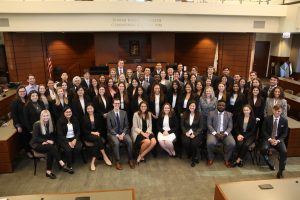Even before starting law school at Loyola, I knew that I wanted to practice intellectual property (IP) law. IP law involves both transactional law and litigation. While transactional law focuses on the creation and review of documents and contracts, litigation focuses on resolving disputes, often in a courtroom setting. While I have always been interested in IP transactional law, I also saw the value of understanding litigation. Understanding litigation can be key to a lawyer’s transactional practice. A transactional lawyer can learn how to better draft documents and contracts so that a dispute (hopefully!) never arises and litigation is not needed.
Because I knew that I wanted to better understand litigation, I tried out for Moot Court at Loyola at the end of my first year of law school. I was so excited when I learned that I made a moot court team, especially the Saul Lefkowitz Intellectual Property team!
What is Moot Court and how do I join?
Moot Court is an extracurricular activity at most law schools focused on appellate level oral and written advocacy. Appellate advocacy occurs when a case is appealed from the trial level and attorneys argue a legal issue in front of a panel of appeals court judges. Moot court is “moot” because the cases are not real, and the competitions take place in a mock courtroom setting. However, many of the judges at moot court competitions are actually real judges, which makes arguing at moot court competitions so exciting!
Moot Court at Loyola is comprised of 16 teams with about 60 members in total. Tryouts take place each spring, and all incoming second-, third- and fourth-year students can try out using their briefs and oral arguments that they wrote in their Legal Writing Courses. Students are then placed on one of 16 teams that each focus on a different legal issue. Since the problems for each competition vary team by team, students can state their preferred team and subject matter on their applications. I knew I was interested in IP, so I was most interested in the Saul Lefkowitz team, which focuses on trademark infringement.
Additionally, each week, all teams come together during the Honors Appellate Advocacy course. Unique to Loyola, this course focuses on advanced legal research, brief writing, oral arguments, and the components of appellate procedure. In addition to their own competitions, all members of moot court competition teams must participate in Loyola’s Intraschool Moot Court Competition held each spring just for Loyola students. All second-, third- and fourth-year students, not just Moot Court members, can participate in the intraschool competition using their briefs and oral arguments they wrote in their Legal Writing III course. Awards are also handed out for the best briefs and the best oralists, so students can engage in some friendly competition with their own classmates!

What is a trademark?
As I mentioned, my moot court team focused on a problem with trademarks. So, what exactly is a trademark?
A trademark is any word, phrase, symbol, design, or a combination of these things that is used in commerce and identifies a business’s goods or services. This means that consumers have an immediate connection with your word or logo and the goods or services that your business provides. Examples of famous trademarks include the word APPLE and its apple logo for technology, MCDONALDS and its golden arches for fast food, and NIKE and its swoosh logo for sports gear. The more unique and fanciful a business’ trademark is, the more effective and easier to protect it can be.
While you can become a trademark owner as soon as you start using your trademark in commerce, registering your trademark with the United States Patent and Trademark Office (USPTO) provides more protections. For example, registering a trademark provides a legal presumption that you own the trademark and have the right to use it. So, in federal court, trademark registration proves ownership, eliminating the need for providing evidence.
When analyzing trademark infringement, courts typically use a factor-based test, analyzing and weighing each factor to determine whether consumers will be confused. While each appellate circuit has a different factor-based test, the factors – regardless of what terms are used – generally focus on the same issue. Among other factors, courts will look at the strength of the plaintiff’s trademark, how similar the trademarks are, how related the goods and services of both the parties are, and the marketing channels the parties’ use.
What is the competition like?

The Saul Lefkowitz Trademark & Unfair Competition Moot Court Competition is an annual competition sponsored by the International Trademark Association (INTA), which is a professional association dedicated to trademark law. The problems for competition each year usually focus on trademark infringement. For example, this year’s problem focused on whether a popular boy band’s use of the phrase “WE’RE OFF THE CHARTS? YOU BTXCHA!” in its tagline infringed on a record store’s registered trademark “OFF THE CHARTS!”.
The first part of competition is submitting the appellate brief for the side your team is assigned – either the petitioner, the party that files the petition to appeal a court’s decision, or the respondent, the party that must respond to the petition. Most students write appellate-level briefs during their first semester of their 2L year, so students are usually familiar with appellate-level writing by the competition’s brief submission deadline.
My team this year consisted of one brief writer (Sophia) and two oralists (myself and my partner, Ben). While Sophia did much of the substantive brief writing, Ben and I helped her with case research and editing. It was exciting to come up with arguments that could help turn a court’s likelihood of confusion analysis in favor of BTX. Among the other likelihood of confusion factors mentioned above, we argued that the record store’s trademark “OFF THE CHARTS!” was not strong because it was a common phrase used in the music industry. We also argued that the two taglines were not similar because BTX’s tagline included three additional words: “WE’RE”, “OFF”, and “YOU BTXCHA!”.
The next part of the competition, is practicing! This is when a lot of the work for the oralists comes in because oralists must present the oral arguments in front of judges at competition. Once the briefs are submitted, teams have about 4 weeks before competition to practice. For us, that meant in-person practice with our coaches five times a week. This amount of practicing helps more than I realized! At competition, oralists must present arguments as both petitioner and as the respondent. Our coaches helped us fine-tune our arguments for both sides and helped us to answer questions that we might get from judges at competition.
Finally, competition day! On February 4th, we competed in the Chicago regional round competition. Honestly, the day felt like it flew by because of all the practice we had with our coaches and how well my team and I got along. We got to argue for both petitioner and respondent and were able to answer any questions that the judges asked. Some of the judges were even federal judges from the Northern District of Illinois!
Even though I am going into transactional intellectual property law, as opposed to litigation, I would not have traded my moot court experience for anything. Moot Court helped me to work alongside others, be intentional about how I present myself, and learn how to effectively communicate when I was asked questions. I encourage everyone interested in IP law to try out for the Saul Lefkowitz Moot Court team during the spring!

Kristen Salas Mationg
Assistant Blogger
Loyola University Chicago School of Law, J.D. 2024
